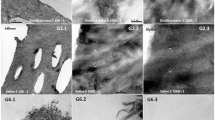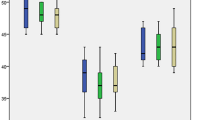Abstract
Objective
To evaluate the effect of several final irrigation protocols on radicular dentin microhardness, biochemical composition, and DMP1-CT expression.
Materials and methods
A total of 140 single-rooted human teeth were prepared with WaveOne Gold files and randomly distributed into 7 groups (n = 20) according to the final irrigation protocol: distilled water (DW); sodium hypochlorite-EDTA (NaOCl-EDTA); EDTA (EDTA); EDTA-NaOCl (EDTA-NaOCl); EDTA-chlorhexidine (EDTA-CHX); passive ultrasonic irrigation (PUI:NaOCl-EDTA); and PUI:NaOCl-EDTA-NaOCl. Dentin microhardness (n = 10) was evaluated in the root canal lumen using Vickers hardness tester. Immunohistochemical analysis (n = 5) was used to evaluate DMP1-CT expression. Dentin ultrastructure and biochemical composition were evaluated by using Raman and energy dispersive X‐ray analysis (EDAX) (n = 5) with a scanning electron microscope (SEM). Analysis of variance (ANOVA) and Tukey test were performed (p˂0.05).
Results
Raman spectra of the organic content and DMP1-CT expression were lower at the lumen canal in EDTA-NaOCl, PUI:NaOCl-EDTA, and PUI:NaOCl-EDTA-NaOCl when compared to control (p < 0.05). EDAX showed reduced values for calcium and phosphorus in EDTA-NaOCl, PUI:NaOCl-EDTA, and PUI:NaOCl-EDTA-NaOCl. SEM microphotography’s showed completely cleaned dentin, permeable tubules, and dentin erosion, mainly when PUI was used. NaOCl-EDTA presented significantly higher microhardness values than PUI:NaOCl-EDTA-NaOCl (p < 0.05). PUI:NaOCl-EDTA-NaOCl exhibited the lowest Vickers hardness values of all groups.
Conclusion
The final irrigation protocols that used a final rinse with NaOCl and PUI showed a detrimental effect on radicular dentin DMP1-CT expression, biochemical composition, and microhardness.
Clinical relevance
The adequate irrigation protocol could be advantageous to preserve the radicular dentin ultrastructure, promote adequate adhesion, and sustain favorable conditions for biomineralization and regeneration.



Similar content being viewed by others
References
Wagner MH, da Rosa RA, de Figueiredo JAP et al (2017) Final irrigation protocols may affect intraradicular dentin ultrastructure. Clin Oral Investig 21:2173–2182. https://doi.org/10.1007/s00784-016-2006-x
Carvalho MPM, Morari VHC, Susin AH et al (2017) Endodontic irrigation protocols: effects on bonding of adhesive systems to coronal enamel and dentin. J Esthet Restor Dent 29:222–228. https://doi.org/10.1111/jerd.12289
Oyarzún A, Cordero AM, Whittle M (2002) Immunohistochemical evaluation of the effects of sodium hypochlorite on dentin collagen and glycosaminoglycans. J Endod 28:152–156. https://doi.org/10.1097/00004770-200203000-00002
Galler KM, Buchalla W, Hiller KA et al (2015) Influence of root canal disinfectants on growth factor release from dentin. J Endod 41:363–368. https://doi.org/10.1016/j.joen.2014.11.021
Dotto L, Sarkis Onofre R, Bacchi A, Rocha Pereira GK (2020) Effect of root canal irrigants on the mechanical properties of endodontically treated teeth: a scoping review. J Endod 46:596-604.e3. https://doi.org/10.1016/j.joen.2020.01.017
Cruz-Filho AM, Sousa-Neto MD, Savioli RN et al (2011) Effect of chelating solutions on the microhardness of root canal lumen dentin. J Endod 37:358–362. https://doi.org/10.1016/j.joen.2010.12.001
Elbahary S, Haj-yahya S, Khawalid M et al (2020) Effects of different irrigation protocols on dentin surfaces as revealed through quantitative 3D surface texture analysis. Sci Rep 10:1–10. https://doi.org/10.1038/s41598-020-79003-9
Cardoso LR, Baldasso FER, Delai D et al (2019) Effect of EDTA, sodium, and calcium hypochlorite on the inorganic component of root canal dentin: a SEM analysis. Microsc Res Tech 82:128–133. https://doi.org/10.1002/jemt.23151
Wang Z, Maezono H, Shen Y, Haapasalo M (2016) Evaluation of root canal dentin erosion after different irrigation methods using energy-dispersive X-ray spectroscopy. J Endod 42:1834–1839. https://doi.org/10.1016/j.joen.2016.07.024
Baldasso FER, Roleto L, Silva VDD et al (2017) Effect of final irrigation protocols on microhardness reduction and erosion of root canal dentin. Braz Oral Res 31:e40. https://doi.org/10.1590/1807-3107BOR-2017.vol31.0040
Galler KM, Widbiller M, Buchalla W, et al (2015) EDTA conditioning of dentine promotes adhesion, migration and differentiation of dental pulp stem cells. Int Endod J 1–10https://doi.org/10.1111/iej.12492
Retana-Lobo C, Guerreiro-Tanomaru JM, Tanomaru-Filho M et al (2020) Non-collagenous dentin protein binding sites control mineral formation during the biomineralisation process in radicular dentin. Materials (Basel) 13:1053. https://doi.org/10.3390/ma13051053
Oya K, Ishida K, Nishida T et al (2017) Immunohistochemical analysis of dentin matrix protein 1 (Dmp1) phosphorylation by Fam20C in bone: implications for the induction of biomineralization. Histochem Cell Biol 147:341–351. https://doi.org/10.1007/s00418-016-1490-z
Qin C, D’Souza R, Feng JQ (2007) Dentin matrix protein 1 (DMP1): new and important roles for biomineralization and phosphate homeostasis. J Dent Res 86:1134–1141. https://doi.org/10.1177/154405910708601202
Orsini G, Ruggeri A, Mazzoni A et al (2008) Immunohistochemical localization of dentin matrix protein 1 in human dentin. Eur J Histochem 52:215–220. https://doi.org/10.4081/1219
(2016) AAE clinical considerations for a regenerative procedure revised 6/8/2016. https://doi.org/10.2334/josnusd.57.213
Khademi A, Yazdizadeh M, Feizianfard M (2006) Determination of the minimum instrumentation size for penetration of irrigants to the apical third of root canal systems. J Endod 32:417–420. https://doi.org/10.1016/j.joen.2005.11.008
Zhang K, Kim YK, Cadenaro M et al (2010) Effects of different exposure times and concentrations of sodium hypochlorite/ethylenediaminetetraacetic acid on the structural integrity of mineralized dentin. J Endod 36:105–109. https://doi.org/10.1016/j.joen.2009.10.020
Chan R, Versiani MA, Friedman S et al (2019) Efficacy of 3 supplementary irrigation protocols in the removal of hard tissue debris from the mesial root canal system of mandibular molars. J Endod 45:923–929. https://doi.org/10.1016/j.joen.2019.03.013
Ozasir T, Eren B, Gulsahi K, Ungor M (2021) The effect of different final irrigation regimens on the dentinal tubule penetration of three different root canal sealers: a confocal laser scanning microscopy study in vitro. Scanning 2021:1–9. https://doi.org/10.1155/2021/8726388
Doǧan H, Çalt S (2001) Effects of chelating agents and sodium hypochlorite on mineral content of root dentin. J Endod 27:578–580. https://doi.org/10.1097/00004770-200109000-00006
Sayin TC, Serper A, Cehreli ZC, Kalayci S (2007) Calcium loss from root canal dentin following EDTA, EGTA, EDTAC, and tetracycline-HCl treatment with or without subsequent NaOCl irrigation. J Endod 33:581–584. https://doi.org/10.1016/j.joen.2006.12.010
Aksel H, Albanyan H, Bosaid F, Azim AA (2020) Dentin conditioning protocol for regenerative endodontic procedures. J Endod 46:1099–1104. https://doi.org/10.1016/j.joen.2020.05.010
Hu X, Peng Y, Sum CP, Ling J (2010) Effects of concentrations and exposure times of sodium hypochlorite on dentin deproteination: attenuated total reflection fourier transform infrared spectroscopy study. J Endod 36:2008–2011. https://doi.org/10.1016/j.joen.2010.08.035
Dumitriu D, Dobre T (2015) Effects of temperature and hypochlorite concentration on the rate of collagen dissolution. J Endod 41:903–906. https://doi.org/10.1016/j.joen.2014.12.020
Retana-Lobo C, Guerreiro-Tanomaru JM, Tanomaru-Filho M, Mendes de Souza BD, Reyes-Carmona J (2021) Sodium hypochlorite and chlorhexidine downregulates MMPs expression on radicular dentin. Med Princ Pr 1–13. https://doi.org/10.1159/000517887
Dunavant TR, Regan JD, Glickman GN et al (2006) Comparative evaluation of endodontic irrigants against Enterococcus faecalis biofilms. J Endod 32:527–531. https://doi.org/10.1016/j.joen.2005.09.001
Estrela C, Estrela CRA, Barbin EL et al (2002) Mechanism of action of sodium hypochlorite. Braz Dent J 13:113–117. https://doi.org/10.1590/S0103-64402002000200007
Teixeira CS, Felippe MCS, Felippe WT (2005) The effect of application time of EDTA and NaOCl on intracanal smear layer removal: an SEM analysis. Int Endod J 38:285–290. https://doi.org/10.1111/j.1365-2591.2005.00930.x
Galler KM, Widbiller M, Buchalla W et al (2016) EDTA conditioning of dentine promotes adhesion, migration and differentiation of dental pulp stem cells. Int Endod J 49:581–590. https://doi.org/10.1111/iej.12492
Qian W, Shen Y, Haapasalo M (2011) Quantitative analysis of the effect of irrigant solution sequences on dentin erosion. J Endod 37:1437–1441. https://doi.org/10.1016/j.joen.2011.06.005
Tanomaru-Filho M, Miano LM, Chávez-Andrade GM et al (2015) Cleaning of root canal system by different irrigation methods. J Contemp Dent Pract 16:859–863. https://doi.org/10.5005/JP-JOURNALS-10024-1771
Siqueira JF Jr, Rôças IN, Favieri A, Lima KC (2000) Chemomechanical reduction of the bacterial population in the root canal after instrumentation and irrigation with 1%, 2.5%, and 5.25% sodium hypochlorite. J Endod 26(6):331–4. https://doi.org/10.1097/00004770-200006000-00006
Shrestha A, Friedman S, Kishen A (2011) Photodynamically crosslinked and chitosan-incorporated dentin collagen. J Dent Res 90:1346–1351
Shrestha A, Hamblin MR, Kishen A (2014) Photoactivated rose bengal functionalized chitosan nanoparticles produce antibacterial/biofilm activity and stabilize dentin-collagen. Nanomedicine 10(3):491–501
Rath PP, Yiu CKY, Matinlinna JP, Kishen A, Neelakantan P, (2020) The effect of root canal irrigants on dentin: a focused review. Restor Dent Endod 30;45(3):e39. https://doi.org/10.5395/rde.2020.45.e39.
Elnawam H, Abdelmougod M, Mobarak A, Hussein M, Aboualmakarem H, Girgis M, El Backly R (2022) Regenerative endodontics and minimally invasive dentistry: intertwining paths crossing over into clinical translation. Front Bioeng Biotechnol 8(10):837639. https://doi.org/10.3389/fbioe.2022.837639
Funding
This work was supported by LICIFO and Vicerrectoria de Investigación, Universidad de Costa Rica.
Author information
Authors and Affiliations
Corresponding author
Ethics declarations
Ethics approval
The research protocol was approved by the Ethics Committee of the Universidad de Costa Rica (VR‐467‐2018).
Consent to participate
Not applicable.
Conflict of interest
The authors declare no competing interests.
Additional information
Publisher's note
Springer Nature remains neutral with regard to jurisdictional claims in published maps and institutional affiliations.
Rights and permissions
About this article
Cite this article
Retana-Lobo, C., Ramírez-Mora, T., Murillo-Gómez, F. et al. Final irrigation protocols affect radicular dentin DMP1-CT expression, microhardness, and biochemical composition. Clin Oral Invest 26, 5491–5501 (2022). https://doi.org/10.1007/s00784-022-04516-8
Received:
Accepted:
Published:
Issue Date:
DOI: https://doi.org/10.1007/s00784-022-04516-8




